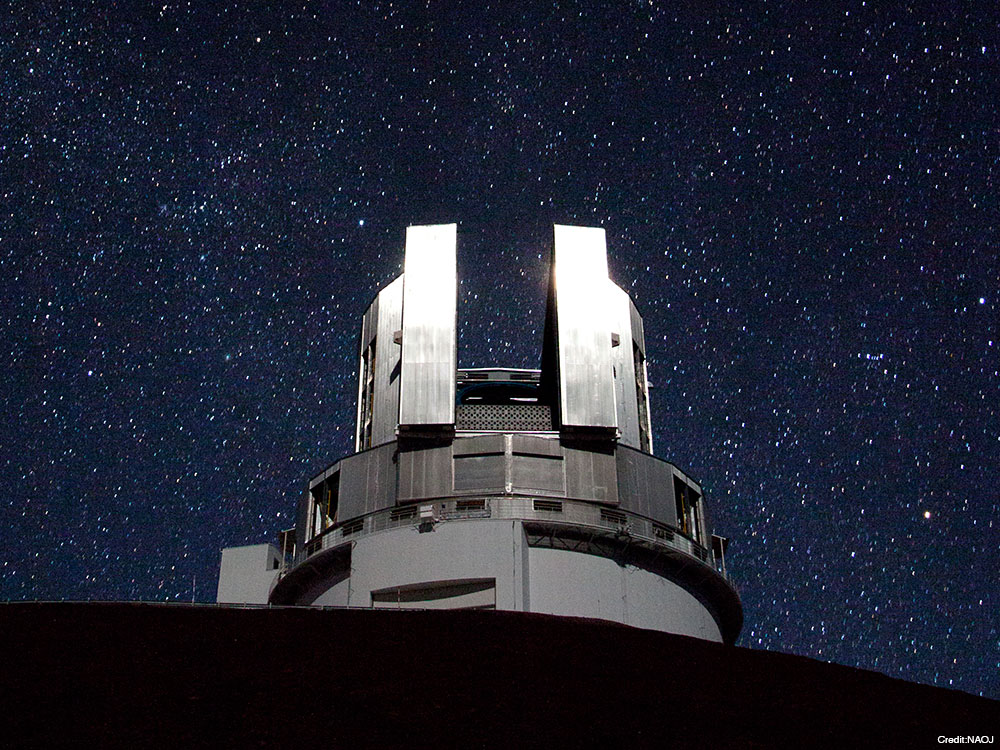About the Subaru Telescope
The Subaru Telescope is a large optical-infrared telescope located near the summit of Maunakea, on Hawai'i Island. The primary mirror is one of the world's largest monolithic mirrors, with an aperture of 8.2 meters. This large light collecting power enables it to capture even the faintest light from celestial objects. A major feature of the Subaru Telescope is its ability to mount instruments at the prime focus where the field of view is overwhelmingly wide compared to other very large telescopes. In addition, the Subaru Telescope is equipped with various innovations to obtain sharp images of celestial objects from the light it collects, such as high-performance adaptive optics, making the Subaru Telescope's high resolving power one of the highest among the world’s very large telescopes. This performance has been achieved through careful selection of the telescope's site and the use of state-of-the-art technology.

Specifications
| Location | Summit of Maunakea on the Island of Hawai‘i, the United States of America (at an altitude of 4139 meters) |
|---|---|
| Prime manufacturer | Mitsubishi Electric Corporation |
| Effective aperture of primary mirror | 8.2 meters |
| Main observation instruments | Prime focus instruments: Hyper Suprime-Cam (HSC), Prime Focus Spectrograph (PFS) Nasmyth focus instruments (visible light): High Dispersion Spectrograph (HDS) Nasmyth focus instruments (Infrared): Infrared Camera and Spectrograph (IRCS) and 188-element Adaptive Optics (AO) System Cassegrain focus instruments: Multi-Object Infrared Camera and Spectrograph (MOIRCS) and Faint Object Camera And Spectrograph (FOCAS) |
| Characteristics | The Subaru Telescope has four foci including the prime focus, Cassegrain focus, and two Nasmyth foci. Among the 8-meter class telescopes in the world, only the Subaru Telescope is capable of mounting an instrument at the prime focus. |
History
| April 1991 | The Japan National Large Telescope plan officially started. Construction of the Subaru Telescope started. NAOJ started production of the primary mirror and began overall design. NAOJ asked people from all over Japan to submit names for the telescope. |
|---|---|
| January 1999 | The Subaru Telescope started test observation (first light). |
| December 2000 | Common use began for the Subaru Telescope. |
| February 2006 | Multi-Object InfraRed Camera and Spectrograph (MOIRCS) started operation. |
| November 2006 | Laser guide star adaptive optics system started operation (first light). |
| November 2010 | Fiber Multi-Object Spectrograph (FMOS) first light. |
| July 2013 | Hyper Suprime-Cam (HSC) first light. |
| February 2025 | Prime Focus Spectrograph (PFS) started operation. |
Related Project
Main Research Results
- Optical/Infrared Telescopes Follow Gravitational Waves to Treasure
- Unprecedentedly Wide and Sharp Dark Matter Map
- Astronomers Discover 83 Supermassive Black Holes in the Early Universe
- Oldest Galaxy Protocluster forms "Queen's Court"
- Machine Learning Finds a Surprising Early Galaxy -- Breaking the Lowest Oxygen Abundance Record
- Record Breaking Distant Solar-System Object
- Subaru Telescope Images Planet Just Starting to Form
- Signature of Very Massive First Stars Recorded in a Milky Way Star
